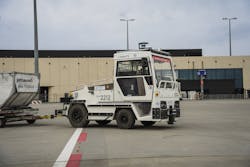Frankfurt Airport (FRA) in Germany features a large apron area, allowing ground personnel to service and turnaround thousands of flights every month.
However, the size of the apron means ground service providers may have to travel long distances, reducing efficiencies and diverting focus away from more complex activities. To combat this, officials at Frankfurt Airport and Fraport Ground Handling Services tested the effectiveness of an autonomous tractor in airside activities.
The first-of-its-kind trial at Frankfurt Airport got underway at the beginning of this year and was conducted through March.
“Autonomous vehicles are a very promising future option for us as an airport operator. We’ve already trialed self-driving vehicles in some areas. But deployment on the apron on such a long route is a completely new dimension,” Eric Agthe, project manager for process and product development at Fraport said in a press release announcing the project.
Testing the Technology
According to Dennis Stein, vice president division development, Logistics and IT, at Fraport Ground Handling Services, the aim of the trial was to determine whether – and under what conditions – an autonomous vehicle could support regular baggage and cargo operations on the apron
The electric vehicle operated on an 8-kilometer test route within the security area of Frankfurt Airport, Stein explains. The test route began in the eastern section of Frankfurt Airport’s apron, inside the baggage handling facility located at Terminal 2. Then the vehicle would travel south towards the future Terminal 3.
“The trial section is divided into three components, each of which poses special challenges for the autonomous vehicle,” Stein says. “These include operations inside the baggage handling facility amidst other traffic and people, as well as in the open where there are few other vehicles.”
Over the course of the trial, the autonomous vehicle operated during different times of day and in varying environments including rain and hot weather conditions.
“During the test operation, the vehicle drove at a maximum speed of 13 kilometers per hour and towed a maximum of three baggage trailers or two large cargo trailers,” he adds, noting a safety driver specially trained and certified for this project was present on each test drive.
Reviewing the Results
Following the three-month trial, project officials came away with a positive outlook.
“The successful proof-of-concept ran from January until March 2023 without any accidents or major occurrences,” Stein reports. “During the test phase, the vehicle completed enough runs to be able to make a valid evaluation.
“Afterwards, we came to the conclusion that the use of an autonomous driving truck for bag transportation and non-critical transfers is realistic under the given circumstances,” he adds.
The test system proved itself under dynamic conditions, including various weather-related influences, different traffic conditions and more, Stein says. As a result, autonomous tractor technology remains a promising project for the airport and its ground handling partners.
“From the extensive tests, we have now identified 16 technical, operational, regulatory and organizational requirement fields,” Stein says, noting training and sensitization of our employees on the apron when using such systems as well as clear signaling at complex intersections as examples.
“We plan to investigate these in further test runs,” he continues. “Whether we will use the vehicles in the future depends on further testing. However, we can already say that their use for non-time-critical baggage transport is quite conceivable.”
Autonomy’s Future at Airports
From Fraport’s point of view, Stein says the use of autonomous vehicles in ground handling has the potential to facilitate more efficient personnel deployment in the future.
“Due to the size of the airport apron, our employees often have to cover long distances,” he says. “If parts of these routes could be operated by autonomous vehicles, the ground services teams would have more flexibility to handle flights even more efficiently and to focus on more complex activities and processes.
“This is all the more true when more transfer baggage transport becomes necessary with the opening of Terminal 3 in 2026,” Stein adds. “Looking to the future, automation can also be a way of counteracting demographic change and increasing employee shortages.”
About the Author
Josh Smith
Editor
Josh Smith served as editor of Ground Support Worldwide as editor from 2016 through 2024. He oversaw production of the print magazine, created GSW's newsletters on a daily basis, and updated the latest news on AviationPros.com.

